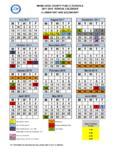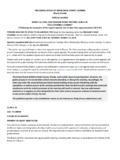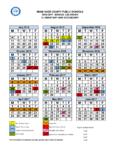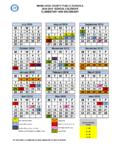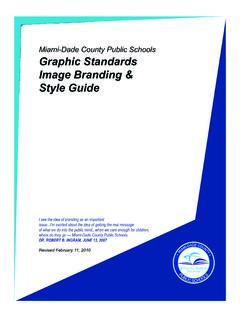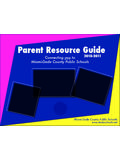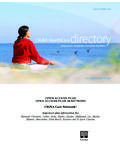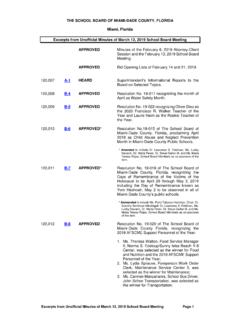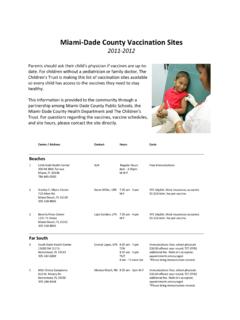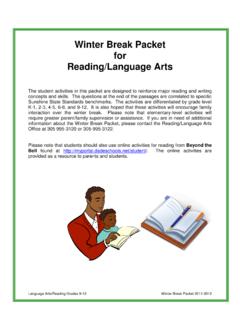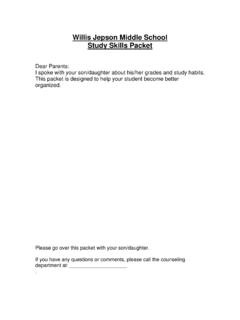Transcription of Winter Break Packet for Reading/Language Arts
1 Winter Break Packet for Reading/Language arts The student activities in this Packet are designed to reinforce major reading and writing concepts and skills, while also being fun and stimulating. The activities are differentiated by grade level: K-1, 2- 3, 4-5, 6-8, and 9-12. It is also hoped that these activities will encourage family interaction over the Winter Break . Please note that elementary-level activities will require greater parent/family supervision or assistance. If you are in need of additional information about the Winter Break Activity Packet for Reading/Language arts , please contact 305 995-3120 or 305-995-3122. Grades 6-8 Winter Break Packet THE SCHOOL BOARD OF MIAMI-DADE COUNTY, FLORIDA. Perla Tabares Hantman, Chair Dr. Lawrence S. Feldman, Vice Chair Dr. Dorothy Bendross-Mindingall Carlos L. Curbelo Renier Diaz de la Portilla Dr. Wilbert Tee Holloway Dr. Martin Karp Dr. Marta P rez Raquel A. Regalado Hope Wilcox Student Advisor Alberto M.
2 Carvalho Superintendent of Schools Milagros R. Fornell Associate Superintendent Curriculum and Instruction Dr. Maria P. de Armas Assistant Superintendent Curriculum and Instruction, K-12 Core Karen Spigler Administrative Director Division of language arts / reading Grades 6-8 Winter Break Packet Middle School reading Holiday Packet Suggestions for Completing the Middle School Holiday Packet The Middle School Holiday Packet has three types of questions: multiple-choice, short-response "Read, Think, and Explain," and extended-response "Read, Think, and Explain" questions. Read the directions carefully. Ask your parents or guardians to help you understand any directions you do not understand. Read the passages and questions very carefully. You may look back at a passage as often as you like. Use highlighters or pencils to underline important information as you read. Answer the questions you are sure about first. If a question seems too difficult, skip it and go back to it later.
3 Think positively. Some questions may seem hard, but others will be easy. Check each answer to make sure it is the best answer for the question. Grades 6-8 Winter Break Packet How to Answer the "Read, Think, and Explain" Questions This symbol appears next to questions that require short written Read answers. Use about 5 minutes to answer each of these questions. You should try to answer these questions even if you are not sure of the Think correct answer. Explain A complete and correct answer to each of these questions is worth 2. points. A partial answer is worth 1 point. This symbol appears next to questions that require longer written Read answers. Use about 10 minutes to answer each of these questions. You should try to answer these questions even if you are not sure of the Think correct answer. Explain A complete and correct answer to each of these questions is worth 4. points. A partial answer is worth 1, 2, or 3 points. Read the question carefully.
4 If you do not understand the question, go back and review the story. Think carefully and organize your thoughts before starting to write your answer. Write your answer on the lines provided in the Student Test Book. Remember to include details and information from the article in your answer. Use clear, concise language to explain your answer. Be sure to answer every part of the question. Reread the answer to make sure it says what you want it to say. Grades 6-8 Winter Break Packet Directions: Read the article Florida s Hummingbirds and answer questions 1 11. Florida s Hummingbirds by Joe Schaefer and Craig Huegel Hummingbirds live only in the Americas. Of the 338 species known, sixteen are found in the United States and three occur in Florida. Black-chinned and rufous hummingbirds occasionally can be seen in Florida during the Winter , but the ruby- throated hummingbird is by far the most common bird in the state. This feathered jewel is about 3 inches ( centimeters) long and weighs as little as a penny (1/4 ounce).
5 Its name describes the most brilliant part of the mature male s plumage. The throat feathers contain air bubbles that give off an iridescent red tone in full light. Both sexes, young and mature birds, have metallic green backs and white-tipped feathers. The ruby-throat s breeding range extends from central Kansas to the east coast and from Saskatchewan to central Florida. Although some birds may stay in South Florida year-round, most spend the Winter in Mexico and South America where the weather is warmer. These tiny hummingbirds, whose wingspans are only 4 inches, fly to and from Florida over the Gulf of Mexico. This represents a trip of 500 to 600 miles that must be made without stopping. To prepare for migration, the birds store up reserves of body fat in order to have sufficient energy. Males arrive back in Florida in March, and females follow them about a week later. GO ON. language arts / reading Grades 6-8 Winter Break Packet 2010-2011.
6 Nesting Nesting in Florida begins in April. The nest is a walnut-size structure of plant 1. down adorned with lichens and moss and bound with spider webs or fine plant fibers. The nests frequently are built over water. The female lays two eggs less than 1/2 inch ( centimeters) long. After twenty days of incubation and four weeks of growing, young hummingbirds leave the nest. Hummingbirds breed from March to July, and a female may have two or three broods during that time. Breeding ends in July so that the birds have time to put on weight for migration. The young hummingbirds return to Florida as adults and are ready to breed the next spring. Flying Feats Migrating annually from South America to Florida and back is only one of the amazing flying feats of the ruby-throated hummingbird. One of the most fascinating things about hummingbirds is their helicopter-like flying stunts. Not only can they suspend their bodies in midair, they also can fly backward, upward, and even upside down.
7 These maneuvers are possible because of a unique design that allows the wing to move very freely and in almost any direction at the shoulder. Since hummingbirds are built more like helicopters than gliders, soaring is the only maneuver that they cannot perform. Contrary to popular belief, hummingbirds do not hum. The sound is made by their rapid wing movements (50 to 200 beats per second). Feeding To acquire enough strength to support all of this high-speed activity, hummingbirds need to consume large amounts of high-energy food. Adult hummingbirds feed primarily on nectar. Young birds are fed insects by their parents, but they have switched to a mostly nectar diet by the time they leave the nest. Nectar is an energy-rich food that hummingbirds use rapidly. One hummingbird may need nectar from hundreds of blossoms every day to maintain its body weight. 1. down: soft fibers from seeds, stems, or hairy leaves GO ON. language arts / reading Grades 6-8 Winter Break Packet 2010-2011.
8 Hummingbirds are well adapted to a liquid diet. Long, needlelike bills and specially-adapted tongues allow them to reach nectar in deep tubular flowers. The last half-inch of the long tongue is divided into equal halves, each grooved on the outside edge to form two tube-like structures. Nectar is drawn into the tongue much the same way liquid travels up a straw. Hummingbirds can lick at a rate of 13 times per second, and their stomachs are capable of holding about ounces (5 grams) of nectar at one time. They also feed, to a lesser extent, on insects. For their size, hummingbirds have among the largest appetites in the bird world. They feed every 10 to 15 minutes from dawn until dusk. During this period, they consume more than half their weight in food and eight times their weight in water. Hummingbirds have developed two adaptations to help them survive the hours of darkness when they cannot feed. First, they eat as much as they can just before dark.
9 During the night, their heart rate and body temperature drop to conserve energy, and they perch lifelessly on a branch. If they did not go into this sort of daily hibernation stage, they would be likely to starve. Gardening for Hummingbirds To be successful in keeping hummingbirds around your house, you must garden for them. The ideal flower color is red, orange, or pink. Hummingbirds are not born with an attraction to certain colors, but they learn by trial and error which flowers give the best results. Because most nectar-bearing flowers within the range of the ruby-throat are red and orange, they quickly come to favor these colors. Hummingbirds also have been known to show an interest in red-colored lipstick, fingernails, and clothing. Tubular flowers that are either large and solitary or flowers that hang in loose, drooping clusters are best. Generally, tubular flowers hold large amounts of nectar at their bases. Blooming season is another important gardening consideration.
10 Nesting hummingbirds will need nectar from March to September. Therefore, your garden should have numerous nectar plants available throughout this time. It is best to plant a variety of species and to arrange these flowers in several groupings. Nesting hummingbirds are very aggressive and territorial around their food source. Having more than one flower garden will allow several birds to feed at the same time without conflict. Cypress Vine Butterfly Milkweed GO ON. language arts / reading Grades 6-8 Winter Break Packet 2010-2011. Tables 1 and 2 show some of the plants that are among the favorites used by hummingbirds in North and Central Florida. While red flowers dominate the list, others have been added to allow for a varied planting. Plants native to Florida are preferable when given the proper growing conditions for the species. Table 1. Hummingbird Plants: Perennials Common Name Adaptability to Region Blooming Season Butterfly Milkweed Native Species Spring Fall Red Basil Native Species Spring Used as an annual in North Shrimp Plant Spring Summer Florida Cardinal Flower Native Species Summer Fall Obedient Plant Native Species Summer Fall Table 2.
